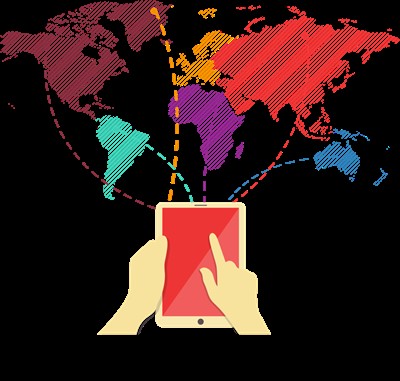Inbound Marketing and Content Translation
“Inbound Marketing” is a term that was coined by Brian Halligan of HubSpot in 2005. The term, as he described it, is the idea of drawing customers in with compelling content, rather than blaring company and product information at them to get their attention.
I like to think of inbound marketing as a person willingly attending a coffee shop discussion on a topic of interest, versus outbound marketing, which I imagine as someone standing on the street corner yelling “READ ALL ABOUT IT” to people who hurriedly rush by with their heads down, avoiding eye contact.
Buyers are now in control. With all the information readily available at their fingertips they can tune out outbound marketing, which can be impersonal and imposing. According to HubSpot, there are 200 million numbers on the Do Not Call List, 44% of direct mail is never opened, and 86% of people skip TV commercials. So now marketers are tasked with finding better ways to attract buyers.

Personas Around the World
The first step in the content equation is researching your buyers and their personas. A buyer persona is defined as, “examples of the real buyers who influence or make decisions about the products, services or solutions you market.” HubSpot has defined nine important questions to ask when researching your buyer personas:
- What is their demographic information?
- What is their job and level of seniority?
- What does a day in their life look like?
- What are their pain points?
- What do they value most? What are their goals?
- Where do they get information?
- What experience are they looking for when shopping for your products and services?
- What are their most common objections to your product or service?
- How do I identify this persona?
These questions provide a good base of where to begin when researching your personas. The more you know about your buyers, the easier it will be to predict their buying habits, allowing you to provide them the content they need, when they need it. Another important aspect of getting the correct content to your buyers at the right time is localization of that content. Translation services should be a top priority for the content you publish. In order for your company’s products and/or services to reach your target markets, customers need to be able to get your information in their own language. Simply translating your content into another language isn’t enough. Localizing your content is crucial.
Understanding your customers’ cultures allows you to know what content should be localized, and it will also give you a deeper knowledge of the spending habits in your target markets. For example, Germany has the largest online population in the European Union, which grew from 29.2% in 2000 to 84% in 2012. But it is also important to note that Germans are very concerned with internet security and 75% will not proceed with online transactions if no security advice is provided. Creating some content for the “security precautions” implemented in your ecommerce site, and translating it into German, would be a smart choice to help encourage potential German customers to be comfortable transacting with you and buying from your site.
In the Brazilian culture, handkerchiefs symbolize grief and mourning, especially when given to a person. The O.K. sign, made by touching your thumb and first finger together creating a circle, is considered a vulgar symbol. Brazil is also a risk-adverse society, and it is important to reduce risk and anxiety for online shoppers.
All of these different components must be given attention if you want to successfully generate business in the global marketplace. For more information to be aware of when localizing and translating your content for cultures around the world, see GPI’s series of whitepapers on Website Globalization and e-Business.

Inbound Marketing Content Localization – the right content in the right place at the right time
Understanding your buyer personas in different countries will help you decide what content is appropriate, and in what languages you need it in. You should translate and localize content in order to engage and win customers in new markets. Whether it is one word, such as an SEO focused keyword used in a PPC campaign or a 200 page eBook, such as a user manual or promotional guide, localized content attracts local customers.
Creating compelling content which attracts buyers is the key to generating new business. Content that should be translated or localized can come in many forms:
- Blogs
- Case Studies
- Podcasts
- Social Media Posts
- Videos
- Websites
However, deciding what types of content you want to produce is only one part of the equation. In order to be successful, you have to publish the right content in the right place at the right time. You must understand your buyers well enough to know what type of information they are looking for, where they are looking for it, and at what point in their buying cycle they are looking for it. Topics of interest will vary from place to place around the globe, stay on top of current events and important dates and publish content accordingly.
An example of the impact of translating your content and making it available globally can be illustrated by GPI’s case study on Live Earth, which is a project of the SOS campaign, calling on people to fight the climate crisis. Live Earth was a 24-hour, 7-continent concert series which took place on 7/7/07. The organization needed to localize sections of their website and documents in up to 19 different languages. GPI worked with Live Earth’s teams to successfully translate and desktop publish their content. The live broadcast of this campaign was viewed by more than 8 million people, making it the most-watched entertainment event in online history.
In Summary
In this global economy there are many business opportunities outside your own country. It may even be detrimental to narrow your audience to one market. The entire world should be your ultimate market. Localization, or translation, of your content should be a core part of your inbound marketing strategy. Making your content globally accessible will attract new customers and open new markets.
Outbound marketing might not be dead, but it sure isn’t as effective as it used to be. Bring your company into the new age of marketing by implementing an inbound strategy. Get to know your customers on a new level, and let them drive your marketing efforts. Create relevant, well-timed and interesting content that will attract customers to and localize your content so you don’t get left out of the global marketplace.
